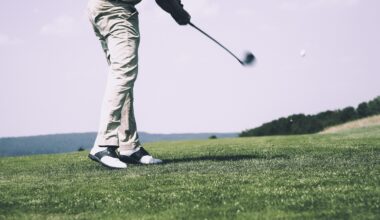Real-Time Feedback Systems for Gait Correction
Gait analysis is crucial for understanding human movement and improving rehabilitation practices. Real-time feedback systems have emerged as innovative tools for gait correction, offering immediate insights and adjustments. These systems utilize advanced technologies, such as wearable sensors and algorithms, to monitor gait patterns. Through data analytics, users receive feedback on their walking techniques, which fosters more effective rehabilitation methods. Accurate feedback loops enable therapists and patients to engage in a collaborative approach to improve mobility. Over time, consistent tracking can yield significant enhancements in gait mechanics. The main goal is to prevent injuries and enhance performance across various populations. Particularly in sports, precise algorithmic analysis helps athletes optimize their biomechanics, breaking down movements into measurable components. Moreover, clinicians can leverage such technologies for personalized treatment plans aimed at specific deficiencies. By parsing data in real-time, these systems not only provide feedback but also contribute to a comprehensive understanding of overall body mechanics. Overall, the integration of this technology represents a vital step forward in biomechanics and rehabilitation, shaping the future of physical therapy and patient care effectively.
The Role of Wearable Technology
Wearable technology forms the backbone of real-time gait analysis systems. Sensors embedded in smartwatches, fitness bands, and specialized clothing capture motion data while users go about their daily activities. Beyond simple step counting, these devices measure a variety of parameters. Key metrics such as stride length, cadence, and joint angles contribute valuable insights into a person’s gait dynamics. This technology empowers individuals to monitor their own progress, gradually fine-tuning their movements. Wearable technologies also offer convenience, seamlessly integrating into lifestyles without interruption. These systems frequently pair with mobile applications, providing users with personalized coaching and recommendations. Users can analyze their walking patterns anywhere, facilitating adjustments in real-time. Furthermore, the data collected can be transferred to healthcare providers for a more detailed assessment. This level of immediacy allows for proactive interventions rather than reactive ones. Enhanced data analytics mean therapists gain access to more comprehensive information than ever before. In addition, improving user experience through gamification encourages patients to actively engage with their rehabilitation process. Ultimately, wearable technology is transforming gait analysis into an accessible, engaging, and effective approach.
Moreover, the integration of machine learning and artificial intelligence into real-time feedback systems enables deep pattern recognition. As these technologies evolve, they learn from historical gait data to formulate precise corrective suggestions. Analyzing past performance helps refine algorithms and enhance predictive capabilities. Practitioners can benefit immensely from tailored recommendations based on individual biomechanics. Consequently, both athletes and casual walkers gain access to actionable insights. These customizable solutions facilitate real-time adjustments and optimize training or recovery processes. Additionally, machine learning systems can identify abnormalities that a human eye might overlook. This function is especially crucial in clinical settings where misdiagnosis can lead to ineffective treatment. As AI continues to refine its understanding of gait patterns, the efficacy of rehabilitation programs will significantly improve. Continued research in biomechanics only adds to the robustness of these systems. This synergy between human expertise and technological advancement will likely pave the way for revolutionary changes in personalized healthcare. Adopting these systems marks a paradigm shift in how gait correction is viewed and implemented in both athletic and therapeutic contexts.
Implementing Feedback Mechanisms
Implementing effective feedback mechanisms is essential for the success of gait correction systems. Immediate feedback encourages users to make necessary adjustments while walking or running. This instantaneous interaction fosters an environment of continuous improvement. By using real-time auditory or visual cues, users feel empowered to alter their movements. Simple prompts can make a substantial difference, nudging individuals toward more efficient gaits. For instance, auditory reminders about cadence can improve running efficiency and reduce the risk of injuries. Furthermore, incorporating visual displays can motivate users and enhance their understanding of their performance metrics. Many feedback systems utilize smartphones or tablets to present data in an engaging format. By providing both quantitative and qualitative feedback, users gain deeper insights into their gait mechanics. Moreover, periodic summaries can help track long-term improvements and set future goals. Encouraging user collaboration with healthcare providers ensures a more holistic approach to rehabilitation. These collaborative relationships fortify the feedback mechanism further, introducing a layer of accountability. Thus, effective real-time feedback mechanisms play a pivotal role in successfully implementing gait correction strategies by nurturing organic growth and better understanding biomechanics.
Furthermore, individual user customization is integral to the efficacy of real-time feedback systems. Each person’s biomechanical profile is unique, requiring tailoring for optimal results. Configuring parameters such as preferred walking speed and stride length encourages adherence and engagement. Customization enables users to set realistic goals specific to their performance levels and rehabilitation needs. This aspect is crucial for maintaining user motivation over time, especially when facing challenges. Additionally, allowing users to select types of feedback they receive can enhance user experience. Some individuals may prefer audio cues, while others might favor visual alerts. By personalizing the feedback experience, users feel more invested in their rehabilitation journey. This personalization often leads to increased compliance with therapeutic exercises, resulting in demonstrable improvements in gait patterns. Moreover, user feedback on the technology itself can drive further innovation, giving developers insights into usability and effectiveness. This continued evolution of real-time feedback systems is imperative for sustainability and growth within the biomechanical field. As developers respond to user needs, the technology becomes increasingly sophisticated and impactful across various populations seeking gait correction.
Ethical Considerations and Future Directions
As real-time feedback systems for gait correction proliferate, ethical considerations become paramount. Personal data privacy is a significant concern, as these systems collect sensitive information on individual biomechanics. Safeguarding this data is crucial for maintaining user trust and compliance with regulations. Additionally, developers must ensure that the systems do not reinforce unrealistic expectations. Transparency about what users can realistically achieve is vital in preventing feelings of inadequacy. This transparency should extend to ensuring responsible use of data, using it purely for therapeutic purposes. Ensuring the safety and well-being of users remains a priority for developers and healthcare providers. Future advancements should focus on improving inclusivity and accessibility, ensuring that diverse populations can benefit from these technologies. Research must also address overcoming barriers of usability for elderly users or individuals with disabilities. As these systems become more integrated into everyday life, a focus on affordability will also be essential. Technological advancements must not result in socio-economic disparities. Therefore, collaboration among various stakeholders—including healthcare professionals, technologists, and ethicists—will be vital in making real-time feedback systems a ubiquitous and equitable tool for gait correction.
In conclusion, real-time feedback systems for gait correction are changing the landscape of biomechanics. By leveraging wearable technology, machine learning, and customized feedback, these systems enhance rehabilitation outcomes significantly. Through immediate corrections and user engagement, patients experience improved mobility, injury prevention, and performance optimization. Furthermore, ongoing innovation positions these systems at the forefront of athletic training and physical therapy. Individualized user experiences enhance adherence to treatment plans, culminating in a deeper understanding of personal biomechanics. As the technology evolves, so too does the potential for wide-reaching impacts on diverse populations. Ethical considerations will guide future developments, ensuring responsible use and equitable access to advancements. Importantly, collaboration across sectors will strengthen the efficacy and sustainability of these technologies. Overall, the marriage of cutting-edge technology and biomechanical principles heralds a new era in movement analysis and rehabilitation. Researchers and practitioners will continue uncovering new possibilities made feasible by real-time feedback systems. This represents not only a step forward in rehabilitation but also a stride towards improving overall health and wellness across various communities.
Summary and Implications
In summary, the advancements in real-time feedback systems for gait correction signify a paradigm shift in rehabilitation strategies within biomechanics. The innovative use of cutting-edge technology allows for immediate feedback and adjustment, fostering personalized therapeutic approaches. Wearable sensors provide athletes and patients with the tools needed to track their progress effectively. As technology becomes more integrated into daily routines, its potential impact on rehabilitation will only grow. The collaboration between developers, healthcare professionals, and users makes for a holistic approach in addressing individualized needs. Ethical considerations surrounding data privacy and accessibility will remain relevant to ensure widespread adoption. Moreover, integrating machine learning enhances the capability of these systems considerably, allowing for tailored recommendations optimized for each user. Addressing usability challenges will further enhance accessibility for populations with unique requirements. Overall, real-time feedback systems present significant implications for improving gait analysis, rehabilitation, and performance optimization. As research continues to unfold, these systems will inevitably change how individuals view physical therapy and rehabilitation for various gait deficiencies. Through this evolution, the future of biomechanics remains bright, with real-time feedback setting the standard for effective rehabilitation solutions.


